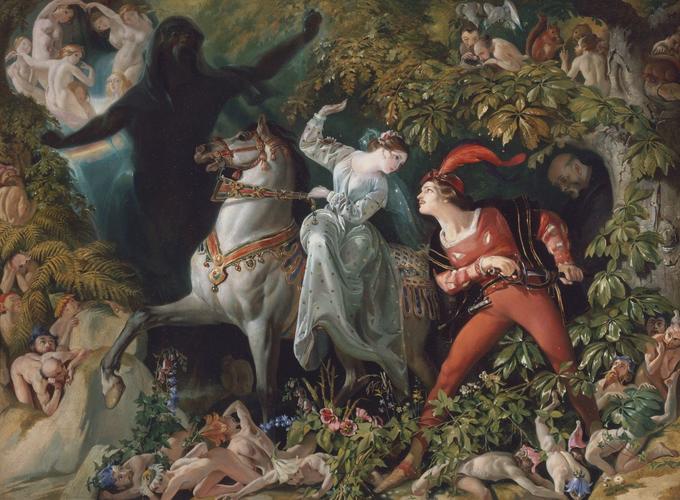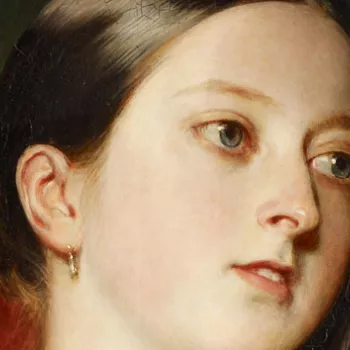A Scene from 'Undine' Inscribed 1843
Oil on panel | 44.5 x 61.0 cm (support, canvas/panel/stretcher external) | RCIN 405638
-
In this scene, taken from the German novel Undine by Friedrich de la Motte Fouqué (1777-1843), the young knight Huldbrand escorts his bride, Undine, through an enchanted forest full of writhing elves and goblins. By her marriage to a human the water spirit Undine gained a mortal soul but lost the prospect of eternal life. Father Heilmann, having just performed the ceremony, emerges from beneath a canopy of trees, while the evil and sinister Kühleborn, spirit of the waters and Undine's uncle, rises up ahead of them in an attempt to return Undine to her family.
By the 1840s the Irish artist Daniel Maclise had established himself as a successful painter, specialising in scenes from literature and the theatre. His style during this decade, as noted by contemporary critics, demonstrates the influence of engraved book illustrations by German artists such as Moristz Retzsch (1779-1857), evident here in the intricate ornamental border of flowers and figures encircling the central scene. Perhaps this was one of the features of the painting which appealed to Prince Albert. The imaginary scene also reflects the particularly British fashion for fairy painting.
Earlier artists such as J. H. Fuseli (1741-1825) and his follower Thomas Wainewright (1794-1847) had drawn upon Fouqué's Undine in the 1820s, but it was in the 1840s that the story seems to have captured the imagination of artists in England. The subject was second only to Goethe's Faust as the most popular German literary or historical source for painters and sculptors during the period. Between 1843 and 1859 eighteen pictures were exhibited at the Royal Academy based on Undine (Vaughan 1979, pp. 257-65). Two other events during 1843 might have provided immediate inspiration for Maclise's choice of subject: the first performance of Perrot's ballet, Ondine, with music by Cesare Pugni (1802-70), and the appearance of a series of engraved illustrations of the story by Julia Emily Gordon (1810-96).
In September 1843 Charles Dickens, a close friend of the artist, wrote that Maclise was 'in great favour with the Queen, and paints secret pictures for her to put upon her husband's table on the morning of his birthday' (House et al, p.549). The Prince was obviously impressed by the young artist and commissioned him to paint a fresco depicting a scene from Milton's Comus for the Garden Pavilion at Buckingham Palace. Maclise was selected to undertake two of the largest fresco decorations for the new Palace of Westminster, The Meeting of Wellington and Blücher (1861) and The Death of Nelson (1865), and collaborated closely with Prince Albert in their design. Growing disheartened with the difficulty of fresco, Maclise was encouraged by the Prince to visit Berlin in 1859 to study the stereochrome process, a technique he adopted upon his return.
Text adapted from Victoria and Albert: Art & Love, London, 2010Provenance
Given to Prince Albert by Queen Victoria on his birthday, 26th August 1843 [Victoria & Albert: Art & Love, London, 2010, pg 460]
-
Creator(s)
Acquirer(s)
-
Medium and techniques
Oil on panel
Measurements
44.5 x 61.0 cm (support, canvas/panel/stretcher external)
72.0 x 88.5 x 5.0 cm (frame, external)
Category
Object type(s)









